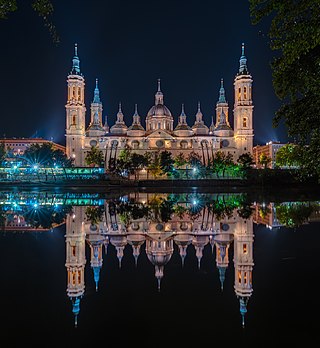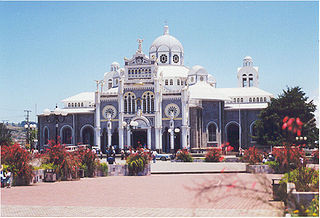
Cartago is the head city of Cartago canton of the Cartago Province, and is composed of the Oriental and Occidental districts as stated in the administrative divisions of Costa Rica. It was the capital of Costa Rica from 1574 to 1824.

The term Black Madonna or Black Virgin tends to refer to statues or paintings in Western Christendom of the Blessed Virgin Mary and the Infant Jesus, where both figures are depicted with dark skin. Examples of the Black Madonna can be found both in Catholic and Orthodox countries.
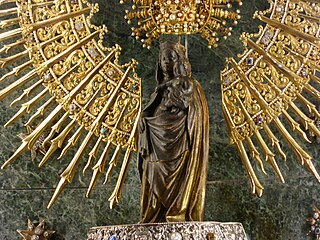
Our Lady of the Pillar is the name given to the Blessed Virgin Mary in the context of the traditional belief that Mary, while living in Jerusalem, supernaturally appeared to the Apostle James the Greater in AD 40 while he was preaching in what is now Spain. Those who adhere to this belief consider this appearance to be the only recorded instance of Mary exhibiting the mystical phenomenon of bilocation. Among Catholics, it is also considered the first Marian apparition, and unique because it happened while Mary was still living on Earth.

The Basílica de Nuestra Señora de los Ángeles is a Roman Catholic basilica in Costa Rica, located in the city of Cartago and dedicated to the Virgen de los Pardos, officially known as Virgen de los Ángeles. The basilica was built in 1639 and was partially destroyed by an earthquake. The basilica has since been restored and constitutes a unique mix of colonial architecture as well as 19th-century Byzantine style; the current building dates back to 1939.
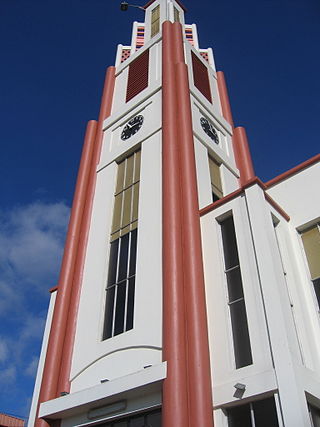
The Diocese of Cartago is a Latin Church ecclesiastical territory or diocese of the Catholic Church in Costa Rica. The Diocese of Cartago in Costa Rica is a suffragan diocese in the ecclesiastical province covering all Costa Rica of the metropolitan Archdiocese of San José de Costa Rica.

Our Lady of San Juan de los Lagos is a Roman Catholic title of the Blessed Virgin Mary venerated by Mexican and Texan faithful. The original image is a popular focus for pilgrims and is located in the state of Jalisco, in central Mexico, 122 kilometers (76 mi) northeast of the city of Guadalajara. The statue is venerated both in Mexico and in the United States where it is known by its proxy title Nuestra Señora de San Juan del Valle, mainly focused in Texas.

Christianity has a strong tradition of pilgrimages, both to sites relevant to the New Testament narrative and to sites associated with later saints or miracles.

The Virgin of Candelaria or Our Lady of Candle, popularly called La Morenita, celebrates the Virgin Mary on the island of Tenerife, one of the Canary Islands (Spain). The center of worship is located in the city of Candelaria in Tenerife. She is depicted as a Black Madonna. The "Royal Basilica Marian Shrine of Our Lady of Candelaria" is considered the main church dedicated to the Virgin Mary in the Canary Islands and she is the patron saint of the Canary Islands. Her feast is celebrated on February 2 and August 15, the patronal feast of the Canary Islands.
Our Lady of Charity is a celebrated Marian title of the Blessed Virgin Mary venerated in many Catholic countries.
Queen of Angels or Our Lady of the Angels is a devotional title of Mary, mother of Jesus. It may refer to:
The Parroquia San Antonio de Padua, commonly known as the Iglesia de Curridabat is a church located in Curridabat, Costa Rica.

The Basilica of the Royal Marian Shrine of Our Lady of Candelaria is a Roman Catholic minor basilica, the first Marian shrine of the Canary Islands, located in the municipality and city of Candelaria on the island of Tenerife. It is located some 20 km (12 mi) south of the island's capital, Santa Cruz de Tenerife.

The El Virilla train accident occurred in Costa Rica on 14 March 1926, when an overcrowded train carrying mostly farmers and laborers derailed while crossing a bridge across the Virilla River Canyon, killing 385 and injuring 93.

Ujarrás is a village and historical site in the Orosí Valley of Cartago Province in central Costa Rica, southeast of the provincial capital of Cartago. It lies near the northeastern bank of the man-made Lake Cachí, created by the damming of the Reventazon River. The dam lies adjacent to the village. The village is connected to Cachí, on the other side of the lake.

Our Lady of Itatí, also known as the Virgin of Itatí, is a Roman Catholic title of the Virgin Mary, whose principal shrine is in the city of Itatí, Corrientes Province, Argentina. Her feast day is celebrated on July 9, with an anniversary celebration on July 16.
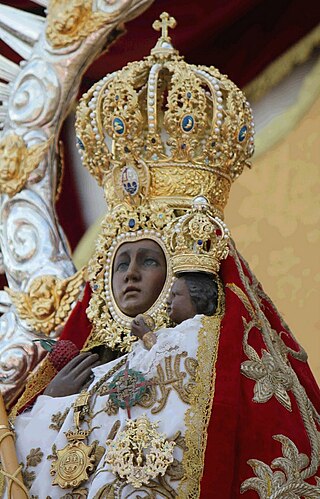
Our Lady of Cabeza is a Marian apparition and statue of the Madonna and Child, whose cult is centered at the Basilica of Nuestra Señora de la Cabeza, located in the Natural Park of the Sierra of Andújar, 32 km north of the city of Andújar, Spain. A Black Madonna, she is known popularly as La Morenita.
Basilica of Our Lady or Saint Mary of the Angels may refer to:

The Our Lady of Carmel Cathedral also called Cartago Cathedral is a religious building belonging to the Catholic Church and is located in the city of Cartago in the homonymous canton of the Central American country of Costa Rica. Not to be confused with a church of the same name in the city of Cartago in Colombia.
The architecture of Costa Rica includes remains from the pre-Columbian Era, all the way to modern buildings that form part of the nation's contemporary infrastructure. There is a unique architectural landscape present in Costa Rica that is reflective of the nation's history and vibrant culture. The nation encompasses an array of historical buildings from both the pre-colonial era and post-colonial era, such as Guayabo and the Basilica of Our Lady of the Angels. The contemporary architectural scene in Costa Rica has also captured global attention, exemplified by structures such as Casa Flotanta. Architecture in Costa Rica is reflective of the nation's environmental conservation policies. This is reflected in the distinctive and extensive presence of canopy bridges throughout the nation, constructed in the aim of preventing rainforest destruction.




